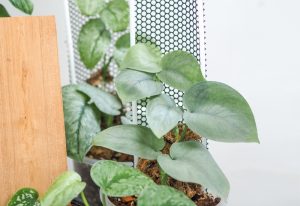If you’re noticing that the leaves of your satin pothos are curling, there may be a few reasons why. In this article, we’ll explore the potential causes of curled leaves and offer some solutions to get your plant back to its healthy, vibrant self.
Causes of Leaf Curling
Underwatering
One of the main causes for curling leaves in satin pothos is underwatering. When the plant does not receive a sufficient amount of water, its leaves will likely curl up as a result [1]. It is essential to check the soil consistently and ensure that it is not too dry. If the soil appears very dry, providing the plant with a good drink should help the leaves perk back up within a few hours.
Overwatering
While underwatering can cause satin pothos leaves to curl, overwatering can also lead to similar issues. Overwatering can leave the soil waterlogged, preventing the roots from absorbing the oxygen they need, and ultimately resulting in root rot [2]. It is crucial to find the right balance of water to prevent leaf curl caused by overwatering.
Temperature Fluctuations
Satin pothos leaves can also curl due to temperature stress. This can occur when the plant is exposed to high temperatures or rapid temperature fluctuations that it cannot tolerate [3]. To avoid this problem, it is essential to maintain a consistent temperature in the room where the plant is located and avoid placing the plant near heat sources or drafty areas.
Lack of Humidity
Low humidity can also cause satin pothos leaves to curl up. Satin pothos prefers higher humidity levels, so if the environment is too dry, the leaves may react by curling. To help maintain proper humidity levels, use a humidity tray or a humidifier [4]. Keep the plant’s surroundings consistently moist to prevent leaf curl caused by low humidity.
Pest Infestations
Lastly, pest infestations can also result in leaf curling in satin pothos plants. Insects such as spider mites, scale insects, or mealybugs can cause the plant’s leaves to curl as they consume its sap [3]. Regularly inspect your satin pothos for any signs of pests and treat infestations promptly to avoid extensive damage to the plant. Appropriate treatments may include insecticidal soap or neem oil applications.
Preventing Leaf Curling
Proper Watering
To prevent leaf curling in Satin Pothos, it’s essential to maintain proper watering habits. Underwatering is a common cause of curling leaves in many houseplants, including Satin Pothos1. Overwatering can also lead to curling, as it leaves the soil waterlogged and the roots unable to absorb oxygen2. Make sure to water the plant when the top inch of soil feels dry, keeping it consistently moist but not saturated.
Temperature Control
Regulating temperature is another crucial factor in preventing leaf curling. Satin Pothos prefers temperatures ranging from 65°F to 85°F3. Keep your plant away from drafty areas or extreme temperature fluctuations to help maintain consistent temperature conditions. If placed near a window, make sure the temperature remains stable, as both hot sun and cold drafts can negatively affect the plant.
Humidity Management
Satin Pothos thrives in environments with high humidity. Maintaining adequate humidity levels is helpful in preventing leaf curling4. Use methods such as placing a humidity tray below the plant, misting the leaves regularly, or using a humidifier to increase the humidity around the Satin Pothos. Grouping plants together can also help increase humidity levels, as they release moisture during the process of transpiration.
Pest Control
Pests can be a common cause of Satin Pothos leaves curling5. Check your plant regularly for any signs of pest infestation, and take appropriate action if you notice pests such as spider mites, aphids, or mealybugs. You can manage pests using natural methods like introducing beneficial insects, spraying with insecticidal soap, or wiping the leaves with a mixture of water and dish soap.
Reviving Curled Leaves
Watering Adjustments
Curled leaves on satin pothos plants are often a result of underwatering. To improve the plant’s health, ensure to keep the soil consistently moist but not soggy. Adjust the watering schedule based on the plant’s needs and environmental factors. Keep in mind that the ideal moisture level varies throughout the year, with more frequent watering required during warmer months and less during colder ones.
Humidity Improvements
Another factor contributing to curled leaves in satin pothos is humidity stress. These tropical plants thrive in a humid environment, so providing adequate humidity is crucial for their well-being. To increase the humidity around the plant, consider using a tray filled with water and pebbles placed under the pot, or place a humidifier nearby. Alternatively, mist the plant with water occasionally to maintain adequate humidity levels. Regular maintenance of humidity will prevent leaf curling and promote healthy growth.
Pest Treatment
Pests can also be a cause of curling leaves in satin pothos. Insects such as spider mites, aphids, or mealybugs may infest the plant and damage its leaves. To address the infestation, thoroughly inspect the plant for any signs of pests, and if detected, remove them using a soft cloth or a soft-bristled brush. For severe infestations, apply a natural insecticidal soap or neem oil as per the directions on the label. Regular monitoring and timely treatment of pests will help restore the health of the satin pothos and prevent curled leaves.
Helpful Video

My name is Daniel Elrod, and I have been houseplant love ever since I was 17. I love how much joy they bring to any room in the home. I’ve always been amazed at how a few pots of flowing leaves can turn a drab and sterile office into an inviting place where people love to work at.

















































































































































































































































